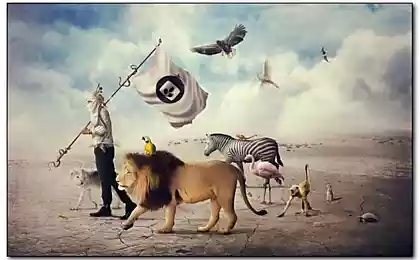264
Why do humans kiss and most animals don’t?
As a result of new scientific research, it was found that about half of human cultures do not practice kissing on the lips. Animals, as it turns out, are not attracted to such caresses either. The BBC Earth correspondent tried to understand the evolution of this strange phenomenon – kissing.

If you think about it, the manner of kissing looks strange, if not quite nasty. You exchange saliva with someone, and sometimes it happens for a long time. In one kiss, up to 80 million bacteria are transmitted, and not all of them are harmless.
At the same time, everyone certainly remembers their first kiss in all the discouraging or delightful details, and kissing continues to play a crucial role in new romantic relationships.
At least in some societies. People in Western countries may think that the exchange of romantic kisses is a universal model of human behavior, but a recent analysis by American anthropologists and sociologists showed that this custom is inherent in less than half of existing cultures. In the animal kingdom, kissing is extremely rare.
What is really behind this strange behavior? If it's useful, why don't all animals kiss and all humans kiss? It turns out that the very fact that most animals don't kiss allows us to understand why others do. According to a new report on the prevalence of kissing, which analyzes the customs of representatives of 168 cultures around the world, only 46% of them kiss in a romantic, loving sense.
The previous figure was 90%. The authors of the new report excluded parents kissing children from their field of view and focused exclusively on the romantic contact of couples touching the lips.
The kiss is not approved in all human cultures.
Many hunter-gatherer communities showed no signs of kissing or a desire to do so. Many even found this behavior repulsive. In the Mehinaka tribe of Brazil, he was called rude (not to say vulgar). Since hunter-gatherers are the closest of all modern humans to the way of life of our ancestors, we can assume that ancient people did not kiss each other.
The report refutes the belief that the manner of exchanging romantic kisses is almost universal for human behavior, says lead author William Jankoviak of the University of Nevada in Las Vegas. In fact, it is rather a product of Western societies, passed down from one generation to the next.
This conclusion is supported by some historical data.
The way we kiss is a relatively recent invention, says Rafael Wlodarski of the University of Oxford in the United Kingdom, who studies the evolution of human behavior. He searched written sources for data on how the habit of kissing changed.
The earliest mention of a behavior resembling the exchange of kisses is found in Hindu Vedic texts in Sanskrit, which are 3,500 years old. They said that kissing means breathing in each other’s soul.
The way we kiss now is a relatively recent invention, scientists say.
In contrast, ancient Egyptian monuments, accompanied by hieroglyphics, depict people closely touching, but not pressing their lips against each other.
So what happens, after all? Is it possible to say that we kiss naturally, but in some cultures this behavior is suppressed? Or is it something that modern humans have invented?
There are some things you can understand by observing the behavior of animals.
Our closest relatives – chimpanzee monkeys and bonobos (a dwarf species of chimpanzee) – kiss. Primatologist and ethologist Frans de Waal of Emory University in Atlanta, Georgia, has repeatedly observed chimpanzees kissing and cuddling after an argument. He wrote about this in his book “Reconciliation among primates”. Chimpanzees have a kiss as a way to make peace
For chimpanzees, kissing is a way to make peace. It is used by males rather than females. In other words, a kiss is not a manifestation of romantic or loving behavior.
Cousins of chimpanzees – bonobos – kiss more often and use language. And this is perhaps not surprising, since bonobos are very sexy creatures.
When two people meet, they can shake hands. Bonobos perform sexual intercourse, which is called the handshake of bonobos. They resort to sex and in many other cases as a manifestation of affection. Therefore, their kisses can not be considered completely romantic.
These primates are more of an exception. As far as we know, other wild animals don't kiss at all. They may sniff each other or touch their faces, but even those with lips do not salivate, grab their mouths, or smack. They just don't need to.
Take, for example, wild boars. Males produce a pungent smell that females find extremely attractive. The main chemical component here is pheromone, a secretion product called androsterone, a male sex hormone that excites the female desire to mate.
It's chemistry.From the female point of view, males with higher levels of androsterone are among the most prolific individuals. She has such a keen sense of smell that she doesn't need to get close enough to kiss a male.
The same is true of other mammals. For example, a female hamster secretes a pheromone that has a very exciting effect on the male. Mice similarly follow a chemical trail, which helps them find genetically different partners, thereby minimizing the risk of accidental incest.
Animals often secrete pheromones in their urine. "Their urine has a particularly sharp smell," says Wlodarski. If the smell of urine is present in the environment, they are able to assess compatibility with each other.
Not only mammals have a keen sense of smell. A male spider belonging to the black widow species can catch the pheromones secreted by the female and from their smell determine whether she has recently eaten. To minimize the risk of being eaten, he mates with his partner only if she is not hungry.
The bottom line is that animals don’t need to get close to each other to smell a good potential mate.
On the other hand, people’s sense of smell is so weak that they only benefit from getting closer to each other. Smell is not the only indicator that allows us to assess the suitability of each other, but experiments show that the sense of smell, however, plays an important role in choosing a partner.
The authors of a report published by the Royal Society in 1995 showed that women, like mice, prefer the smell of men who are genetically different from them. This makes clear practical sense, since mating with an individual endowed with a different set of genes is more likely to produce healthy offspring. A kiss provides a great opportunity to get close enough to smell the genes of the partner. In 2013, Wlodarski studied in detail the preferences of kissing people. He asked hundreds of people what was most important to them when they kissed someone. Smell perception took an important place on the preference scale, and the importance of smell for women increased during periods of their highest fertility.
It turned out that men secrete the same kind of pheromones that the female wild boar finds attractive. It is contained in the sweat of a man, and when women are exposed to it, their level of excitability increases slightly.
From this point of view, when people kiss, they get the opportunity to get so close to another person to get under the influence of his pheromones, while observing certain decencies.
In some cultures, sniffing has evolved into direct contact with the lips. It is hardly possible to determine when exactly this happened, but both of these behaviors serve the same purpose.
So if you want to find the perfect partner, you should probably give up kissing and start sniffing people. Not only will you be able to find a mate, but you will get half as many germs. But be prepared for the fact that you will have to catch the perplexed eyes of others. published
P.S. And remember, just by changing your consciousness – together we change the world!
Source: www.bbc.com/russian/science/2015/07/150721_vert_ear_why_do_we_kiss

If you think about it, the manner of kissing looks strange, if not quite nasty. You exchange saliva with someone, and sometimes it happens for a long time. In one kiss, up to 80 million bacteria are transmitted, and not all of them are harmless.
At the same time, everyone certainly remembers their first kiss in all the discouraging or delightful details, and kissing continues to play a crucial role in new romantic relationships.
At least in some societies. People in Western countries may think that the exchange of romantic kisses is a universal model of human behavior, but a recent analysis by American anthropologists and sociologists showed that this custom is inherent in less than half of existing cultures. In the animal kingdom, kissing is extremely rare.
What is really behind this strange behavior? If it's useful, why don't all animals kiss and all humans kiss? It turns out that the very fact that most animals don't kiss allows us to understand why others do. According to a new report on the prevalence of kissing, which analyzes the customs of representatives of 168 cultures around the world, only 46% of them kiss in a romantic, loving sense.
The previous figure was 90%. The authors of the new report excluded parents kissing children from their field of view and focused exclusively on the romantic contact of couples touching the lips.
The kiss is not approved in all human cultures.
Many hunter-gatherer communities showed no signs of kissing or a desire to do so. Many even found this behavior repulsive. In the Mehinaka tribe of Brazil, he was called rude (not to say vulgar). Since hunter-gatherers are the closest of all modern humans to the way of life of our ancestors, we can assume that ancient people did not kiss each other.
The report refutes the belief that the manner of exchanging romantic kisses is almost universal for human behavior, says lead author William Jankoviak of the University of Nevada in Las Vegas. In fact, it is rather a product of Western societies, passed down from one generation to the next.
This conclusion is supported by some historical data.
The way we kiss is a relatively recent invention, says Rafael Wlodarski of the University of Oxford in the United Kingdom, who studies the evolution of human behavior. He searched written sources for data on how the habit of kissing changed.
The earliest mention of a behavior resembling the exchange of kisses is found in Hindu Vedic texts in Sanskrit, which are 3,500 years old. They said that kissing means breathing in each other’s soul.
The way we kiss now is a relatively recent invention, scientists say.
In contrast, ancient Egyptian monuments, accompanied by hieroglyphics, depict people closely touching, but not pressing their lips against each other.
So what happens, after all? Is it possible to say that we kiss naturally, but in some cultures this behavior is suppressed? Or is it something that modern humans have invented?
There are some things you can understand by observing the behavior of animals.
Our closest relatives – chimpanzee monkeys and bonobos (a dwarf species of chimpanzee) – kiss. Primatologist and ethologist Frans de Waal of Emory University in Atlanta, Georgia, has repeatedly observed chimpanzees kissing and cuddling after an argument. He wrote about this in his book “Reconciliation among primates”. Chimpanzees have a kiss as a way to make peace
For chimpanzees, kissing is a way to make peace. It is used by males rather than females. In other words, a kiss is not a manifestation of romantic or loving behavior.
Cousins of chimpanzees – bonobos – kiss more often and use language. And this is perhaps not surprising, since bonobos are very sexy creatures.
When two people meet, they can shake hands. Bonobos perform sexual intercourse, which is called the handshake of bonobos. They resort to sex and in many other cases as a manifestation of affection. Therefore, their kisses can not be considered completely romantic.
These primates are more of an exception. As far as we know, other wild animals don't kiss at all. They may sniff each other or touch their faces, but even those with lips do not salivate, grab their mouths, or smack. They just don't need to.
Take, for example, wild boars. Males produce a pungent smell that females find extremely attractive. The main chemical component here is pheromone, a secretion product called androsterone, a male sex hormone that excites the female desire to mate.
It's chemistry.From the female point of view, males with higher levels of androsterone are among the most prolific individuals. She has such a keen sense of smell that she doesn't need to get close enough to kiss a male.
The same is true of other mammals. For example, a female hamster secretes a pheromone that has a very exciting effect on the male. Mice similarly follow a chemical trail, which helps them find genetically different partners, thereby minimizing the risk of accidental incest.
Animals often secrete pheromones in their urine. "Their urine has a particularly sharp smell," says Wlodarski. If the smell of urine is present in the environment, they are able to assess compatibility with each other.
Not only mammals have a keen sense of smell. A male spider belonging to the black widow species can catch the pheromones secreted by the female and from their smell determine whether she has recently eaten. To minimize the risk of being eaten, he mates with his partner only if she is not hungry.
The bottom line is that animals don’t need to get close to each other to smell a good potential mate.
On the other hand, people’s sense of smell is so weak that they only benefit from getting closer to each other. Smell is not the only indicator that allows us to assess the suitability of each other, but experiments show that the sense of smell, however, plays an important role in choosing a partner.
The authors of a report published by the Royal Society in 1995 showed that women, like mice, prefer the smell of men who are genetically different from them. This makes clear practical sense, since mating with an individual endowed with a different set of genes is more likely to produce healthy offspring. A kiss provides a great opportunity to get close enough to smell the genes of the partner. In 2013, Wlodarski studied in detail the preferences of kissing people. He asked hundreds of people what was most important to them when they kissed someone. Smell perception took an important place on the preference scale, and the importance of smell for women increased during periods of their highest fertility.
It turned out that men secrete the same kind of pheromones that the female wild boar finds attractive. It is contained in the sweat of a man, and when women are exposed to it, their level of excitability increases slightly.
From this point of view, when people kiss, they get the opportunity to get so close to another person to get under the influence of his pheromones, while observing certain decencies.
In some cultures, sniffing has evolved into direct contact with the lips. It is hardly possible to determine when exactly this happened, but both of these behaviors serve the same purpose.
So if you want to find the perfect partner, you should probably give up kissing and start sniffing people. Not only will you be able to find a mate, but you will get half as many germs. But be prepared for the fact that you will have to catch the perplexed eyes of others. published
P.S. And remember, just by changing your consciousness – together we change the world!
Source: www.bbc.com/russian/science/2015/07/150721_vert_ear_why_do_we_kiss
The discovery of massless particles can seriously speed up electronics
Own state farmer from Virginia, Jeremiah Heaton























